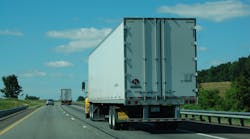There’s a lot of change going on in trucking right now, with the contentious imposition of electronic logging devices (ELDs) but one of the more salient examples.
Trying to keep track of all the trend lines affecting trucking, both inside and outside the industry, can be a daunting task but luckily John Larkin – managing director and head of transportation capital markets research for Stifel Capital Markets – takes a stab at it every year.
So, what should motor carrier executives keep their eyes upon as the New Year starts shifting into high gear? Here’s what Larkin thinks will be key in 2018.
- Automation and reduced regulation not occurring fast enough to keep pace with growing blue collar labor shortage and demand growth.
Larkin thinks that within five to 20 years, depending on the task automation will be broadly enough applied across the global and national supply chains to eliminate, or at least greatly diminish, the current labor shortage. “However, growth of freight demand and additional factors constraining freight hauling and handling capacity could accelerate from here, extending the time frame required to ease the potentially problematical labor shortage,” he warned.
- E-commerce will continue to change the logistics playing field and raise the bar.
E-commerce currently serves roughly 13% of the broader retail market and analysts predict that e-commerce will control 17% of the broader retail market within five years and over 20% in 10 years.
“The dominant, brick and mortar store-based distribution model is gradually being replaced by a less forgiving e-commerce-based fulfillment model that provides less buffer inventory, that requires faster transit times, and that demands more precise pick-up and delivery times,” Larkin said. “There is little question that e-commerce requires a faster, more time-definite, and more tailored supply chain as well as forward positioned inventory that allows for two hour fulfillment, same day delivery, and next day delivery — all to the point of consumption.”
How will all of that affect trucking? Will different freight-carrying trucks be needed to meet more “last-mile” demand? Will smaller-sized trucks be operating on more frequent delivery schedules? Or will drones be performing this work? And how do those demands impact warehouse/distribution center development? In short, the impact of e-commerce on supply chain operations may only be starting.
- Amazon’s insourcing tendency could prove problematical over the longer term.
Amazon – which is in many ways the 900-lb. gorilla of the freight world – challenges its employees to think “outside the box,” said Larkin. “The result of that thinking, so far at least, within the realm of transportation and distribution sector, suggests that Amazon is increasingly supplementing its transportation services vendors with its own capacity,” he explained. “Already the company is building a $2 billion airfreight and parcel hub in Cincinnati. The company has bought its own trailers and contracted with smaller [motor] carriers to pull the freight. We have heard from unverified sources that Amazon will soon purchase its own tractors and will soon contract with major railroads for its own double stack intermodal trains.”
If some or all of that “base load” volume is pulled in house by Amazon, how might that impact broader freight volumes handled by truckers?
- Electric vehicles are coming and at a faster pace than many may expect.
While Larkin noted that while there is disagreement on the extent to which electrically powered vehicles are cheaper to operate than gasoline or diesel powered vehicles, there is agreement that they offer somewhat lower costs in aggregate. “Their motors have less moving parts, require less maintenance, and have a longer expected life,” he said. “And the cost of electricity is generally less volatile than the price of petroleum-based fuels. The challenge is to develop batteries with enough storage capacity to allow for extended runs between recharging opportunities and batteries that are light enough so as to not impinge on the freight hauling capacity of the truck or tractor-trailer.”
The key, Larkin thinks, will be linking electric propulsion with autonomous vehicles. “Environmentalists and cost mavens alike may both support electric trucks, particularly if they are paired with driverless technology,” he said.
- Technology is transforming trucking at an accelerating rate – and will continue to do so.
“There was a time during the earlier stages of my career when virtually no venture capital firms cared about companies operating in the transportation and logistics space,” Larkin said. “My, how times have changed. There are a now plethora of venture capital firms looking to fund companies attempting to bring technology into the broader transportation and logistics space.”
He stressed, though, that the technologies under development – that are currently creating all the “buzz” in the venture capital community – are often focused on automating labor intensive processes such as freight matching, rating, billing, network optimization, fleet management, dispatch, maintenance planning, driver management, and the like.
- The tax bill will be a huge shot in the arm for business overall and for trucking in particular.
One indication is that many motor carriers are currently raising their driver pay 5% to 10% or more, in some cases, even before locking in the rate increases needed to pay for such pay increases. “By the way, the driver shortage/turnover problem is as severe as we have ever seen it, and we have been tracking the industry since the early 80’s,” Larkin added.
On top of that bonus depreciation will incentivize the purchase of more capital equipment and the accelerated replacement of aging trucks, with the new lower effective tax rates most likely harnessed to pay drivers more, renew fleets, and to fund merger and acquisition activity.
“While not many domestic transportation companies will benefit from the repatriation of foreign profits directly, their customers may invest more in the U.S., pay their employees more, and hire more workers as capital comes back to the U.S.,” Larkin said. “Any or all of those initiatives would likely be good for increased freight hauling demand.”
- Industry consolidation is poised to accelerate.
Expanding on his earlier merger and acquisition point, Larkin said consolidation within the freight transportation industry has accelerated in recent years, though, on balance, most sectors remain relatively highly fragmented – especially trucking. “The LTL sector is partially consolidated, while the truck brokerage, drayage, logistics, truckload, and contract logistics segments all remain relatively highly fragmented,” he said. “We would expect operating firms to continue consolidating their industry sectors and/or diversifying their range of services offered in 2018 and beyond. The cost of debt and equity capital remains very low, by almost any reasonable standard, while organic growth is challenged by the lack of qualified, compliant blue collar labor. Plus, customers are becoming increasingly comfortable dealing with fewer, larger, more diversified providers of full logistics solutions.”
- Transportation infrastructure investment remains sorely lacking.
The U.S. interstate highway system “literally changed the complexion of the nation’s economic development witnessed over the last 50 to 60 years,” argued Larkin. Yet little thought was given to the funding mechanism needed to enable this “spectacular civil engineering project” to be properly maintained and expanded over the ensuing decades, he said; thus the end result is a “poorly maintained system” that lacks sufficient capacity in certain parts of the country.
“The cost of this lack of funding is immense given the incremental wear and tear inflicted on vehicles operating over deteriorating pavements and the congestion that prevents the free flow of good and citizens for large portions of the day in and around many of our most important urban areas,” Larkin stressed. “Clearly the transportation network in the U.S. is the primary logistical backbone supporting the existing economy and any incremental growth. It is time for Congress to wake up and address this critical issue or it may run the risk of putting further negative pressure on our global economic competitiveness.”
- Demographic and population shifts will continue to impact freight transportation.
Ongoing population redistribution is creating new “demand patterns” for consumers and new business-to-business demand patterns that impact freight flow volumes and lane balance. In addition, such changes directly drive the need for incremental infrastructure spending. “Supply chain networks also must adapt to the migration,” noted Larkin. “Optimal locations for distribution centers, fulfillment centers, and flexible manufacturing centers, can all change over time as the population shifts. The optimal sourcing decisions for raw materials, parts, and components can also change as the migration pattern continues to evolve. Thus logistics companies, motor carriers, shippers, and receivers all need to be mindful of this slow but sure need to adapt their internal networks and asset allocations to match better match morphing population density trends.”
10. Peak urbanization may have already been reached.
“For many years we have written about the re-urbanization trend: Young college grads and professionals preferring to work, live, and play in trendy neighborhoods close to our ‘urban cores.’ Apartment living was the norm as singles delayed family formation, avoided home ownership – and sometimes automobile ownership – while often prolonging their collegiate social behavior through their twenties.”
However, once “family formation occurs” and children enter the scene – albeit a smaller number of children per family unit than typically of prior generations – migration trends re-accelerate towards the suburbs.
“This accelerating suburbanization, if you will, puts a strain on highway systems and suburban infrastructure – especially in the modern urban regions where jobs are not disproportionately located in the central business district,” Larkin said. “With reduced population density in the suburbs, last mile delivery is complicated, by the increased distance between stops, the reduced number of parcels per stop, and worsening traffic congestion.”
Thus, just when re-urbanization was predicted to simplify and create last-mile delivery efficiencies while reducing peak hour demand on the transportation network as a whole, Larkin the “white picket fence dream” may be experiencing a revival – and thus foment yet another shift in logistics needs.
Needless to say, all of the above is a heady mix of trends that’s hard to absorb in one sitting. Thus we’ll revisit Larkin’s projections as the year progresses to see what ones gain speed and which ones veer from their expected paths.




